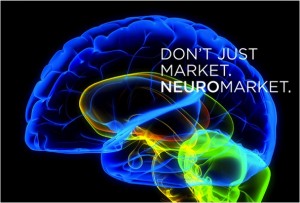Neuromarketing & Big Data seem to be the new buzzwords in the Marketing and communications world. I disagree. Although these two topics are relatively new, I can bet that both will become the new normal pretty soon.
As Marketers and Communicators, I believe we should not only know about these topics, but should also be on the road to understanding how these trends will impact our approach to strategy, design and implementation of IMC plans.

Today, laggard brand managers and IMCers are struggling to catch up, but it’s never too late to begin.
If you’re doubting whether to read further, just think about how long it took you to jump onto the Digital Marketing and Advertising bandwagon, and how much you wish that you would’ve done so earlier…
The first topic is Neuromarketing. Neuromarketing is “a science that’s based on the fact that 95% of all thoughts, emotions, and learning occur before we are ever aware of it, according to Roger Dooley, the author of Neuromarketing and Brainfluence.
 That means most of us are actually only talking to 5% of our potential customers’ brains!” – The full article is from Fast Company (Ethan Hale- Jan 2013) and is The Basics of Neuromarketing. I invite you to take a look and expand your research from there.
That means most of us are actually only talking to 5% of our potential customers’ brains!” – The full article is from Fast Company (Ethan Hale- Jan 2013) and is The Basics of Neuromarketing. I invite you to take a look and expand your research from there.
Another good one is I’m not your consumer: How research misses the human behind the demographic. (Douglas van Praet – EVP @ Dutsch LA – Fast Company Co.Create, March 2013) . Much in line with the brilliant Chapter 4 – on Output vs. Outcomes on Young’s Brand Media Strategy book , this article gives another perspective on how our traditional quant/qualitative research methods, e.g. focus groups media number-crunching, are completely useless because of our irrationality.
We are human beings, not consumers. Consumers is an outdated term for a mindless mass of drones. We are people, not audiences. As we’ve learned in our program, audiences are passive, not reactive. Even if our choices are limited, we the people are the ones in control.
The second topic is big data and analytics in advertising and marketing. The models we commonly use involve some kind of correlation between sales, quantitative and qualitative consumer research that helps us sleep at night with the illusion that we know our cons…, er, people and what they/we want.
Nonetheless, we all know that brand-people interaction has become infinitely complex and that those who learn ho to adapt to real-time changes in reaching people at every touchpoint will be the winners in a large battle for the very limited span of attention that we the people give to our brands and messages.
This is where big data pitches in to help. Many marketers large and small have already made inroads into the use of big data. This article from the HBR – Advertising Analytics 2.0 – shows how it works and how to make the most of it. But what is Big Data? SAS defines it as “a popular term used to describe the exponential growth, availability and use of information, both structured and unstructured” .
By engaging in three broad activities, Nichols lays out a very interesting plan on how to use the massive amount of data about what we do, where, when, and how we do it for us to transform all of it into information, find insight and attempt to answer the all important question: why we do it.
Enjoy the readings and I hope this post helps us all keep an eye on what going on in these areas so we can reap the competitive rewards further down the road.


3 Responses to WHY WE SHOULD CARE ABOUT NEUROMARKETING & BIG DATA